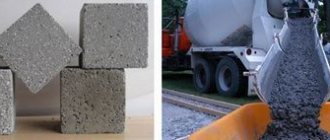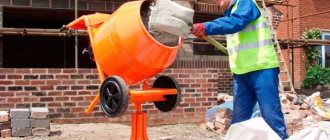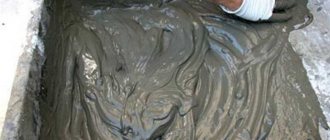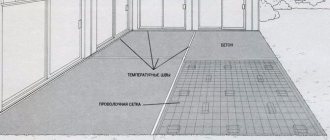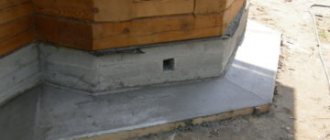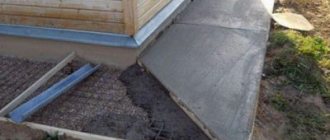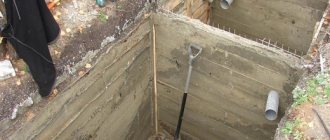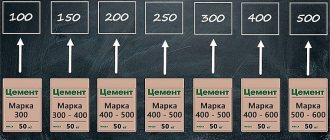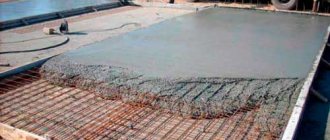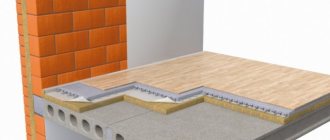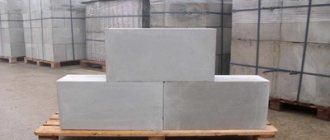At every construction site for private or industrial purposes, a concrete composition is used. The quality characteristics of this building material depend on the skillful use of the components and their proper mixing. Today, manufacturers of building materials provide a wide selection of concretes suitable for solving a variety of problems. For clarity, let’s consider the composition of concrete m300 per 1m3.
Concrete composition
In the simplest case, concrete consists of three components:
- Binder.
- Aggregate.
- Water.
The consumption of materials per 1 m3 of concrete is determined by the properties of these materials. Cement grades M100-M600 in terms of strength are used as a binder in the production of the mixture. When mixed with water, a viscous mass is formed, which, when hardened, forms an artificial stone. Sand or various types of crushed stone are used as filler. This increases the strength of the hardened mortar, since the strength of crushed stone is higher than the strength of cement. In addition, the use of aggregate reduces the shrinkage of the cement mixture.
In addition to the main components, the concrete composition includes various additives that give the solution additional properties: frost resistance, water resistance, color, etc.
The required consumption of materials per 1 m3 of concrete - crushed stone, cement, sand - is determined based on the requirements for the characteristics of the mixture.
Methods for mixing concrete
There are two ways to prepare building concrete yourself:
- Mix the solution by hand;
- Use a concrete mixer for mixing.
Manual mixing of concrete
- First pour the required amount of sand into a clean container;
- Strictly observing the proportions, pour cement on top. Mix both fillers well until their color becomes uniform;
- Measure out the required amount of water and add it in small portions to a container with sand and cement, while simultaneously distributing and mixing the mixture over the entire area. The result should be a gray mass without lumps and visible residues of sand and cement;
- The final step is to add crushed stone to the resulting solution. Kneading should occur until each pebble is covered with the solution. To give the concrete the necessary plasticity, add water if necessary.
The disadvantages of the manual method include the following:
- Quite a labor-intensive and lengthy process;
- Immediate use of the solution after mixing. Otherwise, the solution may begin to delaminate, which will lead to a deterioration in its quality.
Mixing with a concrete mixer
- Pour a small amount of water into the concrete mixer drum, then add cement and mix well until you get gray milk. From this point on, the drum should rotate continuously;
- Next, according to the calculation of proportions, proceed to filling in fillers (sand and crushed stone). Stir for another 2-3 minutes;
- Add a couple more liters of water to the resulting mixture until a homogeneous consistency is obtained.
Mixing concrete in a concrete mixer
The main advantage of this mixing method is the possibility of using concrete within an hour after mixing the solution.
Basic characteristics of concrete
The most important characteristic of concrete is its compressive strength. Depending on it, the strength class is established. It is designated by the English letter “B” and numbers corresponding to the strength of the sample in MPa. Concretes of classes from B3.5 to B80 are produced; in civil engineering, B15 - B30 solutions are most applicable. In addition to classes, a brand can be used to indicate strength. It is designated by the Latin letter “M” and a number corresponding to the strength in kg/cm2. The classes and brands correlate quite accurately with each other, for example, the M200 solution corresponds to class B15, and M300 to class B22.5.
The consumption of materials per 1 m3 of concrete can vary significantly depending on the required class or brand of mortar.
It should be noted that the actual class of concrete is determined only in laboratory conditions on the 28th day. Therefore, if it is necessary to know exactly the brand of the mixture, then at the stage of its preparation several samples should be cast - cubes or cylinders with a height of 100 mm. It is also possible to determine the strength of concrete using an instrument method or a Kashkarov hammer, but these methods are less accurate.
Calculation tables
The tables below indicate the consumption of each material per 1m³ of concrete, depending on its brand.
Cement
| Construction type | Concrete grade | Cement brand | Consumption (kg) |
| Simple products | M100 | 300/400 | 225 |
| Reinforced concrete elements | M150 – M300 | 300 – 600 | 265 – 380 |
| Reinforced sections | M400/M500 | 600 | 480 – 530 |
Water
| Concrete grade | Cement brand | Water/cement ratio |
| 100 | 200, 250, 300 | 0,68 0,75 0,8 |
| 150 | 200, 250, 300, 400, 500, 600 | 0,5 0,57 0,66 0,7 0,72 0,75 |
| 200 | 200, 250, 300, 400, 500, 600 | 0,35 0,43 0,53 0,58 0,64 0,66 |
| 250 | 200, 250, 300, 400, 500, 600 | 0,25 0,36 0,42 0,49 0,56 0,6 |
| 300 | 250, 300, 400, 500, 600 | 0,28 0,35 0,42 0,49 0,54 |
| 400 | 400, 500, 600 | 0,33 0,38 0,46 |
Sand and crushed stone
Now you can determine the amount of sand and crushed stone per m³ of solution of various brands. To do this, it is necessary to subtract the volumes of water and cement from one cube. The total amount will determine the proportion of sand and fillers. Please note that the ratio of ingredients is affected by the coarseness of the sand, and this must be taken into account when mixing a high-quality solution.
| Crushed stone (size in mm) | Sand % | Water (ml/m³) |
| 10 | 56 | 230 |
| 15 | 52 | 220 |
| 20 | 49 | 200 |
| 25 | 46 | 195 |
| 40 | 41 | 185 |
| 50 | 39 | 177 |
| 70 | 35 | 167 |
Having the information presented, as well as armed with a calculator, you can easily find out how many materials are needed to prepare a cube of cement mortar. Now you know what you need to pay attention to first of all in order to get a quality product that meets all the requirements of modern construction.
Selecting the required concrete class
The required grade of concrete must be indicated in the design documentation for the construction site. If the construction is carried out independently, you should decide on the brand of the mixture, since this will decisively affect the strength and cost of the building or structure being constructed.
The purpose of the most common grades of concrete is given below.
- M100 - used for constructing concrete footings, installing parquets, and small architectural forms;
- M150 – used for constructing paths and sealing fence supports;
- M200 – for the construction of walls, porches;
- M250 – production of monolithic foundations, grillages, foundation slabs, light-loaded floor slabs, stairs, retaining walls;
- M300 – for any loaded structures: walls, ceilings, foundations;
- M350 – load-bearing walls, columns, floors, beams, monolithic foundations.
Application area
Let us note that M200 . This mixture is widely used in private construction and is used in the construction of multi-story buildings.
M300 is rarely purchased by private developers: among the possible brands, this mixture occupies an intermediate class in terms of strength. However, in multi-storey construction and the construction of complex structures, such concrete is indispensable.
The intended purpose is as follows:
- strip and slab foundations;
- bored piles;
- grillages and blind areas;
- floor slabs and supporting structures;
- road construction;
- production of reinforced concrete structures.
Concrete M300 is designed for harsh operating conditions; it is poured on difficult soils and high humidity levels.
Sand parameters
To prepare the solution, sand of various origins is used: quarry or river. The second is more preferable, since it has a larger granule size and does not contain impurities. Quarry sand can vary in its granulometric composition. It is preferable to use sand with medium to large granule sizes. Since quarry sand may contain clay or other impurities, it is recommended to sift it.
It is extremely important to pay attention to the moisture content of the sand. Depending on this, you should adjust the amount of water added to the mixture. Taking into account humidity and granulometric composition, the density of bulk sand can vary from 1.3 to 1.9 t/m3; this must be taken into account when calculating the consumption of materials per 1 m3 of concrete.
Advice from the experts
Experienced builders advise preparing a small amount of concrete at home in order to experimentally determine the required density. In addition, a feature of mortar materials is that they set very quickly, so a large volume of the mixture may simply not have time to be worked out.
When mixing the concrete composition, the volume of the mixture decreases noticeably. About 0.7 m³ of the finished solution will come out of a cube of dry components. Therefore, to prepare 1 m³ of concrete mass, you need to use dry ingredients in larger quantities.
To prevent the formation of technological voids in the finished construction elements after hardening, gravel of various calibers should be used. The normal size of sand grains that enter the solution is considered to be particles of 3.5 mm. In addition, the sand should not contain clay impurities, which could cause the mixture to lose its strength.
Make sure that the water for pouring the screed is clean and does not contain foreign matter (silt, algae, dirt). The plasticity index of concrete and its strength after hardening depend on the amount of water. Remember that it is much easier to add water than bulk ingredients, so add the liquid gradually. The smaller the size of the solution ingredients, the greater the water consumption in each cube of the mixture.
Rigid concrete can be easily identified by its appearance. To do this, place a small amount of viscous mass on the shovel, which should not spread over the surface.
Selection of crushed stone
Crushed stone in a concrete mixture increases the strength of concrete and reduces its shrinkage during hardening. When choosing crushed stone, its fraction and origin are of greatest importance.
Crushed stone fractions are used in construction:
- from 5 to 20 mm;
- from 20 to 40 mm;
- from 40 to 70 mm.
Depending on the raw material, crushed stone is classified into:
- Limestone, based on sedimentary rocks.
- Gravel made from rounded rock fragments.
- Granite, obtained by crushing granite and granite-gneiss rocks.
Granite crushed stone has the best strength parameters, so if concrete is being prepared for critical structures - foundations, columns, floors, then it is better to use it. We must not forget that the crushed stone used should not contain impurities, especially clay.
Water cement ratio
In the production of concrete, the ratio of cement and water is of primary importance. Water is necessary for the chemical reaction of cement hydration, leading to the formation of cement stone. This ratio decisively determines the class of the concrete mixture. It is important to take into account the brand of cement. The lower the water-cement ratio, the stronger the concrete. The minimum ratio required for cement hydration is 0.2. In practice, concretes with a water to cement ratio of 0.3-0.5 are used. Mixtures with a high water-cement ratio are practically not used.
Calculation of concrete consumption for strip foundations
This is the most common type of foundation for private construction.
Strip foundation
When calculating the amount of materials and concrete consumption for such a foundation, the width of the tape (usually 20-40 cm), length, height (about 50 cm) of the future foundation and its depth are taken into account.
We perform simple calculations for the same room 10 by 10 m:
- The perimeter of the foundation will be: 10 x 4 = 40 m.
- Width – 0.3 m. Total height: 1+0.5 =1.5 (filling depth + height above the ground).
- Foundation volume: 40 x 0.3 x 1.5 = 18 m3.
Therefore, to pour a strip foundation for a 10 by 10 m site, you will need 18 m3.
If the project includes internal walls at the site, it is necessary to add to the calculations an additional volume for pouring the foundation underneath them.
Determining the proportions of the concrete mixture
As a rule, cements of the M400 and M500 grades are used to prepare concrete. In practice, to determine the cement consumption per 1 m3 of concrete, the following table is used.
| Concrete grade | Consumption of cement grade M500, kg/m3 |
| M100 | 180 |
| M150 | 210 |
| M200 | 250 |
| M250 | 310 |
| M300 | 360 |
| M400 | 410 |
| M500 | 455 |
These data are given for conditions with normal temperature and humidity, as well as for cement whose parameters correspond to those indicated on the packaging. In real life, an excess of cement of 10-15% should be provided.
Next, using a known amount of cement, the consumption of materials per 1 m3 of concrete is calculated; the optimal proportion of cement to sand and crushed stone is shown in the table.
| Concrete | proportion of shares of cement, sand and crushed stone | |
| brand M400 | brand M500 | |
| M100 | Ts1 : P3.9 : Ш5.9 | C1: P5.1: Shch6.9 |
| M150 | Ts1: P3.0: Ш4.9 | C1 : P4.0 : Shch5.7 |
| M200 | Ts1 : P2.3 : Ш4.0 | C1 : P3.0 : Shch4.7 |
| M250 | C1 : P1.7 : Ш3.2 | C1 : P2.3 : Shch3.8 |
| M300 | C1 : P1.5 : Ш3.1 | C1 : P2.0 : Shch3.5 |
| M400 | C1 : P1.1 : Ш2.4 | C1 : P1.3 : Shch2.6 |
| M450 | Ts1 :P 1.0 :Sch2.0 | C1 : P1,2 : Ш2,3 |
For example, the consumption of materials per 1 m3 of M200 concrete will be: cement grade M500 - 240 kg, sand - 576 kg, crushed stone - 984 kg, water - 120 liters.
Proportions by concrete grade
| Brand of Portland cement | Concrete grade | Proportions by volume, l | Concrete volume, l, at a consumption of 10 l. cement | ||
| Cement | Sand | Rubble | |||
| 400 | 100 | 1 | 4,1 | 6,1 | 78 |
| 150 | 1 | 3,2 | 5,0 | 64 | |
| 200 | 1 | 2,5 | 4,2 | 54 | |
| 250 | 1 | 1,9 | 3,4 | 43 | |
| 300 | 1 | 1,7 | 3,2 | 41 | |
| 400 | 1 | 1,1 | 2,4 | 31 | |
| 450 | 1 | 1,0 | 2,2 | 29 | |
| 500 | 100 | 1 | 5,3 | 7,1 | 90 |
| 150 | 1 | 4,0 | 5,8 | 73 | |
| 200 | 1 | 3,2 | 4,9 | 62 | |
| 250 | 1 | 2,4 | 3,9 | 50 | |
| 300 | 1 | 2,2 | 3,7 | 47 | |
| 400 | 1 | 1,4 | 2,8 | 36 | |
| 450 | 1 | 1,2 | 2,5 | 32 | |
| The amount of water is not specified and depends on the required consistency and plasticity of the concrete. | |||||
Concrete can be mixed either manually or mechanically. Of course, the second option provides greater quality concrete, since it creates a mixture that is homogeneous in composition, evenly distributing all the ingredients.
Concrete production
For large volumes of concrete work, it is advisable to buy ready-made concrete at the nearest plant with delivery by mixer. In industrial production conditions, the norms of material consumption per 1 m3 of concrete are maintained quite strictly. If this is not possible, you can prepare the required amount of the mixture at home. It is important to correctly assess your capabilities - concreting a separate structure must be carried out in one go.
Before mixing the mixture, determine the consumption of materials per 1 m3 of concrete. It is not necessary to calculate the consumption rate of the components; it is enough to use the table below.
| Brand of solution produced | Mixture composition, kg | |||
| Cement M400 | Crushed stone | Sand | Water, l | |
| M75 | 173 | 1085 | 946 | 210 |
| M100 | 212 | 1082 | 871 | 213 |
| M150 | 237 | 1075 | 856 | 215 |
| M200 | 290 | 1069 | 794 | 215 |
| M250 | 336 | 1061 | 751 | 220 |
| M300 | 385 | 1050 | 706 | 225 |
The mixture is prepared in a concrete mixer of the appropriate volume, adding measured portions of dry cement, sifted sand and crushed stone. It is recommended to add water in portions last.
Main process
It's time to move from theory to practice. For work we will need:
- cement;
- sand;
- water;
- crushed stone;
- bucket;
- concrete mixer;
- large container (trough).
We will measure the consumption of the constituent components per 1 m³ of concrete with a shovel or bucket. To determine the correct amount of ingredients, we will carefully consider them, and based on the characteristics of each component, as well as the required brand of concrete, we will prepare the building mixture. So, we will evaluate:
- volume, size, voids, presence of organic and clay impurities, sand moisture;
- strength, mass, humidity, presence of grains in crushed stone;
- activity, brand, weight of cement;
- volumetric mass, degree of mobility, water permeability of the initial mixture.
To achieve a certain grade of concrete, for each cube we will need 30 kg of cement, 150 kg of gravel or crushed stone and 90 kg of sand. The volume of water will be expressed in parts. So, 15 liters of water for our mixture will be equal to half the amount of cement.
Supplements
In addition to the main components, additives for various purposes are added to the concrete composition:
- Modifiers. Designed to increase the strength and frost resistance of concrete.
- Plasticizers. Increases the mobility and water resistance of the mixture.
- Mobility regulators. Allows you to extend the setting period and maintain mobility during transportation.
- Anti-frost additives. Ensure normal setting of the solution at low temperatures, down to minus 20 degrees.
- Setting accelerators. They increase the setting speed, ensuring the fastest possible strength gain in the first day.
When using additives, the consumption of materials per 1 m3 of concrete should be determined taking into account the manufacturer’s recommendations. Violation of the instructions for use can have the completely opposite effect.
